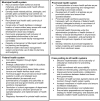Multidomain and multilevel strategies to improve equity in maternal and newborn health services in Nepal: perspectives of health managers and policymakers
- PMID: 37237251
- PMCID: PMC10214695
- DOI: 10.1186/s12939-023-01905-7
Multidomain and multilevel strategies to improve equity in maternal and newborn health services in Nepal: perspectives of health managers and policymakers
Abstract
Background: Nepal has committed to achieving universal coverage of quality maternal and newborn health (MNH) services by 2030. Achieving this, however, requires urgently addressing the widening inequity gradient in MNH care utilisation. This qualitative study examined the multidomain systemic and organisational challenges, operating in multi-level health systems, that influence equitable access to MNH services in Nepal.
Methods: Twenty-eight in-depth interviews were conducted with health policymakers and program managers to understand supply-side perspectives of drivers of inequity in MNH services. Braun and Clarke's thematic approach was employed in analysing the data. Themes were generated and explained using a multidomain (structural, intermediary, and health system) and multi-level (micro, meso and macro) analytical framework.
Results: Participants identified underlying factors that intersect at the micro, meso and macro levels of the health system to create inequity in MNH services. Key challenges identified at the macro (federal) level included corruption and poor accountability, weak digital governance and institutionalisation of policies, politicisation of the health workforce, poor regulation of private MNH services, weak health management, and lack of integration of health in all policies. At the meso (provincial) level, identified factors included weak decentralisation, inadequate evidence-based planning, lack of contextualizing health services for the population, and non-health sector policies. Challenges at the micro (local) level were poor quality health care, inadequate empowerment in household decision making and lack of community participation. Structural drivers operated mostly at macro-level political factors; intermediary challenges were within the non-health sector but influenced supply and demand sides of health systems.
Conclusions: Multidomain systemic and organisational challenges, operating in multi-level health systems, influence the provision of equitable health services in Nepal. Policy reforms and institutional arrangements that align with the country's federalised health system are needed to narrow the gap. Such reform efforts should include policy and strategic reforms at the federal level, contextualisation of macro-policies at the provincial level, and context-specific health service delivery at the local level. Macro-level policies should be guided by political commitment and strong accountability, including a policy framework for regulating private health services. The decentralisation of power, resources, and institutions at the provincial level is essential for technical support to the local health systems. Integrating health in all policies and implementation is critical in addressing contextual social determinants of health.
Keywords: Inequity; Maternal and newborn health services; Multi-level; Multidomain; Nepal; Underlying challenges.
© 2023. The Author(s).
Conflict of interest statement
The authors declared that they have no competing interests.
Figures
Similar articles
-
High coverage but low quality of maternal and newborn health services in the coverage cascade: who is benefitted and left behind in accessing better quality health services in Nepal?Reprod Health. 2022 Jul 19;19(1):163. doi: 10.1186/s12978-022-01465-z. Reprod Health. 2022. PMID: 35854265 Free PMC article.
-
Prioritization of maternal and newborn health policies and their implementation in the eastern conflict affected areas of the Democratic Republic of Congo: a political economy analysis.Health Res Policy Syst. 2024 Apr 30;22(1):55. doi: 10.1186/s12961-024-01138-2. Health Res Policy Syst. 2024. PMID: 38689347 Free PMC article.
-
Utilisation of quality antenatal, delivery and postnatal care services in Nepal: An analysis of Service Provision Assessment.Global Health. 2021 Sep 6;17(1):102. doi: 10.1186/s12992-021-00752-x. Global Health. 2021. PMID: 34488808 Free PMC article.
-
Evaluation of the National Health Insurance Program of Nepal: are political promises translated into actions?Health Res Policy Syst. 2023 Jan 20;21(1):7. doi: 10.1186/s12961-022-00952-w. Health Res Policy Syst. 2023. PMID: 36670433 Free PMC article. Review.
-
Private sector quality interventions to improve maternal and newborn health in low- and middle-income countries: a scoping review.Front Public Health. 2025 Apr 9;13:1332612. doi: 10.3389/fpubh.2025.1332612. eCollection 2025. Front Public Health. 2025. PMID: 40270745 Free PMC article.
Cited by
-
Transforming health in Nepal: a historical and contemporary review on disease burden, health system challenges, and innovations.Health Res Policy Syst. 2025 May 20;23(1):61. doi: 10.1186/s12961-025-01321-z. Health Res Policy Syst. 2025. PMID: 40394610 Free PMC article. Review.
-
Menstrual Exile: Nepal's Chhaupadi and the Policy-Practice Divide.Int J Public Health. 2024 Dec 16;69:1608202. doi: 10.3389/ijph.2024.1608202. eCollection 2024. Int J Public Health. 2024. PMID: 39737006 Free PMC article. No abstract available.
References
-
- World Health Organization. : Declaration of Astana: Global Conference on Primary Health Care: Astana, Kazakhstan, 25 and 26 October 2018. In.: World Health Organization; 2019.
-
- WHO and UNICEF. : A vision for primary health care in the 21st century: towards universal health coverage and the Sustainable Development Goals. In: (WHO/HIS/SDS/2018X) Geneva 2018. - PubMed
-
- Nguyen K-H, Jimenez-Soto E, Morgan A, Morgan C, Hodge A. How does progress towards the MDG 4 affect inequalities between different subpopulations? Evidence from Nepal. J Epidemiol Commun Health. 2012-201503;2012:jech. - PubMed
-
- Khatri RB. Towards equity of maternal and newborn health services in Nepal. PhD Thesis The University of Queensland, Australia; 2021.
Publication types
MeSH terms
LinkOut - more resources
Full Text Sources
Miscellaneous



